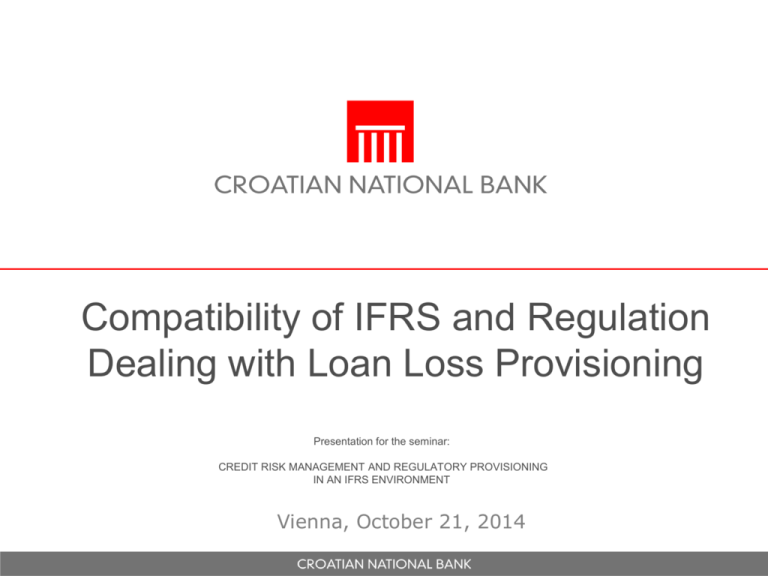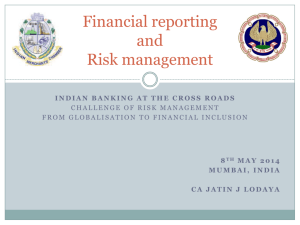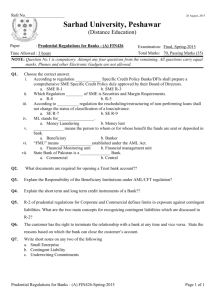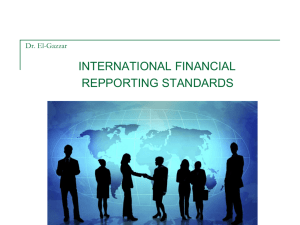Compatibility of IFRS and regulation dealing with loan
advertisement

Compatibility of IFRS and Regulation Dealing with Loan Loss Provisioning Presentation for the seminar: CREDIT RISK MANAGEMENT AND REGULATORY PROVISIONING IN AN IFRS ENVIRONMENT Vienna, October 21, 2014 Regulatory Framework for NPL Recognition and Provisioning – the Case of Croatia Run-up to Crisis the Croatian National Bank traditionally applies a wide array of prudential regulation established through subordinate legislation (“decisions”)signed by the governor; the adherence of banks to the decisions is supervised by the banking supervision departments prudential regulation is created based on experience with the 1998-2000 crisis, when a significant part of the banking system collapsed or was bailed out through massive and extremely costly government support that situation created public and political awareness about risks associated with banking operations in the 2000-2006 period, due to positive market developments and consistent regulation, bank portfolios were mopped up from the crisis impact: NPLs decreased below 5%, and they were provisioned for by 60% the effects of prudential regulation improved due to active application of macro-prudential measures Regulatory Framework the Accounting Act – introduces IFRS as standard accounting practice in Croatia (especially for banks) the Credit Institutions Act & the Act on the Croatian National Bank – give supervisory and regulatory powers to the CNB the Decision on the Classification of Placements and Off Balance Sheet Liabilities – creates operational framework for supervision and accounting of credit risk Basic Accounting & Prudential Framework before 2013 NPL definition: non-collateralised: 90 days past due collateralised: loans which will not be fully recovered, depending on the estimation of cash flows, but at the latest two years after taking legal actions by activating collateral provisioning based on IAS 39 modified by: compulsory classification as NPL (with at least minimal provisions) 90 days past due if no legal action was taken 30% compulsory provisioning two years after legal action was taken to collect the loan for non-collateralised loans prescribed provisioning depending on past-due time buckets: 90 – 180 days past due, up to 30% 180 – 270 days past due, 30% up to 70% 270 – 365 days past due, 70% up to 100% more than 365 days past due, 100% the interest on NPLs is recognised only if collected (not based on accrual) Dynamics of NPL and Provision Coverage 2005-2014 NPL ratio and coverage, Croatia 18% 15,7% 16% 14% 56,8% 55% 12,4% 11,2% 54,4% 50% 48,7% 10% 6,2% 6% 46,2% 7,8% 42,8% 5,2% 4,8% 4,9% 48,0% 38,8% 35% 4% 30% 2% 25% 20% 2005 2006 2007 2008 2009 NPL ratio 45% 40% 41,4% 42,6% 0% 65% 60% 13,9% 60,3% 12% 8% 16,6% 2010 2011 2012 2013 1H2014 From 2007 until 2010 NPL coverage radically decreased in spite of stable regulation. As coverage stagnated subsequently, in 2012 it became obvious that prudential regulation isn’t getting proper traction. Coverage-right decrease of coverage is the consequence of inflow of fresh, low provisioned NPLs, but also of sometimes quite imaginative and very brave collection plans on-site examination was used as an auxiliary tool with some success; the majority of coverage increase in 2011 and 2012 was its contribution; active resistance of banks to risk recognition created extremely high workload for both staff and management of the CNB the lack of standard NPL definition increased the problem, as banks claimed that our NPL definition is stricter than in other jurisdictions, so coverage rates are not comparable Comparative Dynamics I Bulgaria Slovenia 18% 15,0% 16% 120% 11,9% 109,9% 100% 100,4% 80% 8% 6,4% 77,1% 6% 2,2% 2,1% 14% 61,4% 58,2% 2,4% 59,5% 63,0% 60% 40% 2% 0% 20% 2007 2008 2009 2010 NPL ratio 2011 60% 8,2% 8% 5,8% 36,9% 4,2% 21,1% 0% 2012 20% 2008 2009 2010 15,1% 6% 80% 13,7% 14% 8% 10,0% 60% 50% 6,3% 49,4% 5,8% 46,1% Coverage-right 17,6% 15,8% 13,4% 14% 10% 40% 40,3% 40,2% 40,0% 39,6% 30% 2% 80% 70% 16% 64,8% 60% 9,8% 57,1% 50% 6,7% 8% 40,0% 4% 2013 20% 12% 46,0% 2012 18% 70% 11,7% 6,6% 2011 Hungary Italy 9,4% 40% 30% NPL ratio 16% 10% 50% 40,6% 23,3% Coverage-right 12% 45,3% 47,4% 4% 2% 2006 70% 11,8% 10% 6% 90% 80% 15,2% 12% 10% 4% 18,0% 18% 16% 14% 12% 20% 16,6% 46,3% 6% 43,6% 4% 3,0% 37,4% 38,9% 2008 2009 2010 2,6% 2,3% 2006 2007 49,1% 47,8% 40% 30% 2% 0% 20% 2006 2007 2008 2009 NPL ratio Source: IMF, FSI Tables 2010 2011 Coverage-right 2012 2013 0% 20% NPL ratio 2011 Coverage-right 2012 2013 Comparative Dynamics II NPL coverage, Croatia and countries with similar NPL ratio 120 % 100 80 60 40 20 0 2006 2007 Ireland Croatia Source: IMF, FSI Tables 2008 2009 Italy Hungary 2010 2011 Slovenia Romania 2012 2013 Bulgaria Issues Noted major weaknesses recognized in accounting practices were: 30% provisioning was required two years after taking legal action to collect the loan; to avoid it, banks simply didn’t take legal action (initiate foreclosure) after 30% provisioning no additional provisioning was compulsory in spite of process duration and complexity “running two year gap” – cash flow from collateral was always expected two years from now; typical IAS 39 based evaluation was based on the best case scenario; in supervised banks all estimates of time and sale price of real estate collateral proved drastically wrong in evaluation, the real estate value is average of the following three components: market value, replacement value and present value; market value was based on the last known similar transaction (frequently before 2008) discontinued projects were evaluated as completed auditors confirmed everything, providing that it could technically be presented under IFRS framework findings of on-site examinations and shareholders' reactions to these findings made obvious that the management and the owners jointly pursue a strategy of optimistic valuation and that auditors are ready to support it Change of Regulation in 2013 amendments to the Decision on the classification of placements were adopted those amendments made the following changes: compulsory provisioning was regulated in detail: compulsory 10% provisioning 90 days past due (delinquency), if no collateral was activated compulsory 20% provisioning one year after delinquency, if adequate collateral was not activated compulsory 30% provisioning two years after delinquency, regardless of legal action taken to activate a collateral; after accounting for 30%, each 6 months an additional 5% compulsory provisioning minimum of 1% provisions was established for NPLs regulation of restructured loans (how to treat them after restructuring, criteria for their rehabilitation into performing loans) compulsory minimum haircuts and collection periods were introduced for real estate and movable property consecutive compulsory provisions (10%, 20%, 30%) were aimed at motivating banks to timely start foreclosure, while the additional 5% provisioning was a kind of “lump sum” correction for all other noticed aberrations from best practice; others are meant to adjust NPL & forbearance definition to the new definition approved by EBA BoS (ITS on supervisory reporting regarding forbearance and non-performing exposures) Impact of Regulation the introduction of the Decision amendments was designed to have full accounting impact by end-2013 the consequences were obvious: the cost of provisioning increased from 4 to 6 billion kuna – roughly for 0,5% of total assets, reaching 89% of operational results the coverage of NPLs by value adjustments increased from 42,6% to 46,2% but: the banking system remained overall profitable workout operations and sale of NPLs intensified banks’ overall and operational results in 1H2014 improved significantly compared with the same period last year in spite of stricter regulation International Financial Reporting Standards (IFRS) and Prudential Regulation IFRS IFRS offer standardised reporting framework they facilitate transparency of markets and comparability of different investment opportunities the optimal allocation of capital depends on proper application of IFRS The valuation of certain asset classes under IFRS is sensitive to assumptions applied When Arbitrary decisions influence IFRS reports? core portfolios, such as performing loans and all positions created through arms length transactions are evaluated based on “pure” IFRS prudential regulation interferes only with “marginal” high risk portfolios: NPL & problem loans, litigations, regulatory breaches and deviations from good corporate governance the valuation of such positions is based on subjective judgment about future outcome. the implementation of prudential standards limits subjective judgment, increasing comparability of banks’ accounts prudential reports will materially deviate from IFRS reporting only if the bank has a very risky business profile. Reporting is the responsibility of the management. If they find the regulatory requirements misleading, they should adjust the regulatory reporting through a “statement of differences” for tax and shareholders reporting purposes. Preconditions for IFRS Effectiveness the precondition for accurate accounting is an active supervision of management reporting by shareholders motivated to recognize the real value of their assets in banking, regulation could strongly influence the rational behavior of shareholders, making them more relaxed toward overvaluation of bank’s assets In certain circumstances rational shareholders would motivate management and auditors to apply optimistic assumptions in valuation of bank’s assets. If so, IFRS loose its major purpose – providing comparable accounts Shareholders’ Benefits from Optimistic Valuation if an institution is close to a regulatory minimum, rational shareholders would attempt to fulfill the regulatory requirement with “ghost capital”. the “ghost capital” created through optimistic valuation would improve regulatory compliance and, due to avoidance of dilution, (modeled in appendix), increase the expected RoE; additionally, it would create immediate material benefits for managers without regulatory interference, such a strategy is financially superior to prudent accounting in extreme cases such motivation did create “moral hazard” without effective regulatory checks an obvious temptation does exist; to increase the robustness of the system, the regulation should establish the minimum required level of prudence IAS 39 offers the possibility to increase the capital buffer through an optimistic valuation of NPL/problem loans. Protecting Public Interest prudent bank accounting protects the key public interest because: banking is a critical infrastructure of the economy and its robustness depends on proper accounting in several countries banks’ managers recently acted as “fiscal agents”, effectively ruining or at least hampering the fiscal position properly acting supervisors/regulators decrease fiscal risks and improve the financial stability Historically, financial impact of too optimistic banking accounting is obvious and significant, most likely exceeding any potential adverse impact of prudential regulation Conclusion does prudential regulation distort financial reporting to the level hampering transparency of financial markets? we argue that, banks’ management, shareholders and auditors have common incentive to use “income smoothing”, achieved through optimistic discretion within IFRS framework; incentives strengthen if bank approaches the regulatory limits by limiting such behavior banking regulation improves comparability of accounts banks’management has tools to rectify the requirements of prudential regulation in reporting to shareholders prudential regulation is public and transparent, so it can’t distort public information; anyway, if distortion appears, its potential adverse effect is only speculative and obviously smaller than potential effects of improper banking accounting IFRS shouldn’t be a straightjacket for banking regulation. Their subjective elements open a possibility for the banks to overestimate capital, potentialy creating a significant fiscal impact! Thank you for your attention! Appendix Comparative NPV – Retained Earnings Year 0 Bank has regulatory capital 100 and annual AT profit 10. Bank has 100 shares. Discounting factor for calculation of NPV is 5% All profit goes to retained earnings. prudent accounting profit AT Equity optimistic accounting profit per share NPV profit AT Equity profit per share 0 -50,00 100,00 -0,5000 0 10,00 110,00 0,1000 1 11,00 111,00 0,0550 1 10,00 120,00 0,1000 2 11,22 122,22 0,0561 2 10,20 130,20 0,1020 3 11,44 133,66 0,0572 3 10,40 140,60 0,1040 4 11,67 145,34 0,0584 4 10,61 151,22 0,1061 5 11,91 157,24 0,0595 5 -50,00 101,22 -0,5000 Stock price 1,1907 0,9329 Stock price 2,1620 Scenario: Scenario: In year 0 due to increased risk No recognized risks in year 0 recognized one off provisioning Loss recognized in year 5 and covered from reserves cost 60 creating loss 50. Loss is covered from existent equity. Capital shortage was covered through public issuance of shares. Fresh capital increased profit for 1 Stock price in year 6 is 20 *PPS (profit per share adjusted for one-off items) NPV 1,6940 Comparative NPV – Dividend Payout Year 0 Bank has regulatory capital 100 and annual AT profit 10. Bank has 100 shares. Discounting factor for calculation of NPV is 5% All profit goes to dividend. prudent accounting profit AT Equity profit per share optimistic accounting dividend NPV profit AT Equity profit per share dividend NPV 0 -50,00 100,00 -0,5000 0,0000 0,0000 0 10,00 100,00 0,1000 0,1000 0,1000 1 11,00 100,00 0,0550 0,5000 0,0524 1 10,00 100,00 0,1000 0,1000 0,0952 2 11,00 100,00 0,0550 0,5000 0,0499 2 10,00 100,00 0,0980 0,1000 0,0889 3 11,00 100,00 0,0550 0,5000 0,0475 3 10,00 100,00 0,0980 0,1000 0,0847 4 11,00 100,00 0,0550 0,5000 0,0452 4 10,00 100,00 0,0980 0,1000 0,0806 5 11,00 100,00 0,0550 0,5000 0,0431 5 -50,00 100,00 -0,5000 -0,5000 -0,3918 0,2381 Stock price 1,1000 0,8619 NPV CF 0,0576 Stock price 2,0000 1,1000 NPV CF Scenario: Scenario: In year 0 due to increased risk No recognized risks in year 0 recognized one off provisioning Loss recognized in year 5 and covered by shareholders cost 60 creating loss 50. Loss is covered from existent equity. Capital shortage was covered through public issuance of shares. Fresh capital increased profit for 1 Stock price in year 6 is 20 *PPS 1,5671 1,6247 Bibliography Vincent Bouvatier, Laetitia Lepetity, Frank Strobelz “Bank income smoothing, ownership concentration and the regulatory environment”; November 19, 2013 Laeven, L., Levine, R., “Bank governance, regulation and risk taking”., Journal of Financial Economics 93, 259.275. 2009. Morgan, D. “Rating banks: risk and uncertainty in an opaque industry.”, The American Economic Review 92, 874.888. ., 2002 Chen, Linda H., Income Smoothing, Information Uncertainty, Stock Returns, and Cost of Equity (October 1, 2012). Review of Pacific Basin Financial Markets and Policies (RPBFMP), Chen, Tai-Yuan and Chin, Chen-lung and Wang, Shiheng and Yao, Chun, The Effect of Mandatory IFRS Adoption on Bank Loan Contracting (January 8, 2013). Available at SSRN: http://ssrn.com/abstract=2159001 Calomiris, Charles W , Haber, Stephen H.”Fragile by Design”, Princeton University Press, (2014),ISBN 978-0-691-15524-1


